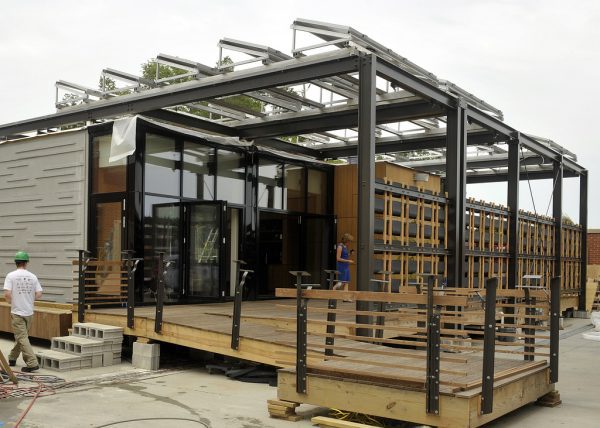Sustainable home prepares for cross-country journey

It took them two years to design and build it, but over the next two weeks, a team of UNC Charlotte architecture, business and engineering students will tear down their solar-powered home, Urban Eden.
But that’s only because the home must be deconstructed, loaded on a flatbed trailer and shipped to Orange County, Calif., where it will compete in the 2013 U.S. Department of Energy Solar Decathlon against other student-built homes from Austria, Canada, the Czech Republic as well as the United States. It will be put back together again when it arrives.
|
Photo Gallery Scroll below or click here to see a photo gallery of Urban Eden by Wade Bruton. |
The 800-square-foot home is equipped with:
- A capillary tube system in the walls to passively heat and cool the space.
- Adjustable photovoltaic panels to provide shade while collecting solar energy.
- A dashboard system to report energy use.
- A geopolymer façade made of recycled fly ash to insulate the space and reduce noise.
A panel of judges will rank the home in 10 different contests ranging from market appeal to appliance efficiency, and announce a winner.
The one-bedroom, one bath home, which the Department of Energy estimates to cost $350,000, is designed to house a young professional or a retired couple. A drop-down desk in the master bedroom creates office space, and a wall bed built into an entertainment center can turn the living room into a guest bedroom.
“I just hope reassembling the house goes smoothly and there are no major hiccups,” said Ben Futrell, a solar decathlon project manager and a student in UNC Charlotte’s Infrastructure and Environmental Systems Ph.D. program.
The home is intended for a young professional or retired couple looking for what the team’s website calls, “a place of peace inside the bustle of the city.” The team envisions Urban Eden as an urban infill project, filling awkward or unused property between existing buildings in an urban community.
“It’s a dense space for a relatively small plot of land,” said Michelle Todd, a Solar Decathlon graduate assistant and master of architecture candidate at UNC Charlotte. “If you’re given a weird urban space, you can make this house fit.”
Solar Decathlon judges will rank the home’s design and sustainable features in 10 contests ranging from market appeal to appliance efficiency.
Futrell said Urban Eden’s strength is its use of simple technologies in new ways.
“The geopolymer, coupled with the capillary tube system, isn’t cutting-edge technology, but it is cutting-edge application of very simple technology that hopefully others will learn from, mimic and improve,” Futrell said. “These things existed before, but were never combined in the way we’re using them.”
Geopolymer is an alternative form of concrete made with fly ash, a waste product of burning coal. It has similar mechanical characteristics to widely used Portland cement, but decreases the carbon associated with traditional concrete manufacturing by 90 percent. The geopolymer walls of Urban Eden reduce urban noise and insulate the home. They also house a capillary tube system which helps cool or heat the home by strategically pumping water throughout the walls. The team is the first to use the alternative concrete in a residential context.
Click to watch video by Urben Eden team.
Multidisciplinary approach
The sustainable vision for Urban Eden was made a reality by the interdisciplinary student team.
Geopolymer concrete had to be poured and set by civil engineering students and materials experts from the architecture school.
The photovoltaic panels had to be sized by electrical engineering students and oriented by students from the architecture school’s daylighting lab.
The HVAC system had to be designed by engineering students and fit into the home by architecture students. Each feature of the home was touched by students with different specialties.
“The home makes you realize it (sustainability) is a multidiscipline thing. You can’t live in your bubble,” said Todd.
Students had to use specialized knowledge developed by the architecture school as well as by the engineering college’s technical curriculum. The project also forced them to develop some soft skills which can’t be learned in the classroom.
“To be honest, I mostly learned management skills. Just logistical and management skills,” said Futrell. “There wasn’t a whole lot of intersect with my research.”
Todd focused on Urban Eden’s vertical garden system – planters arranged along a vertical wall – and helped with construction, two areas she’s comfortable with from studying architecture. But the competition forced her not only to use her knowledge, but required help from engineering students. She said the interaction with teammates from outside of her field prepared her for the workplace.
“Coming out of school it’s good to know that if I work at a firm I’m not going to want to sit behind a desk, I’m going to want to communicate with engineers and contractors,” said Todd.
The team doesn’t know yet what will happen to the home after the competition.
See more photos of Urban Eden by Wade Bruton in the slideshow below.
[view:slideshow2=block_1]